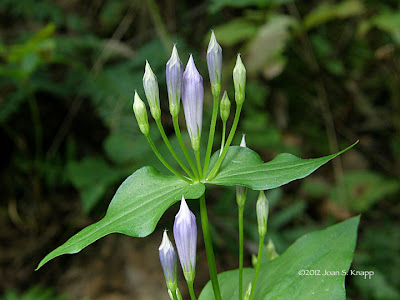September 15th, 2012. We drove over
Patterson Gap Road from Betty’s Creek Road to Persimmon Road. Patterson Gap
lies on the Tennessee Valley Divide in the Chattahoochee National Forest. The
road is graveled and water erosion has produced some rough sections.
Our first find was Lobelia
siphilitca (Great Blue Lobelia). Further up the road – at about 2,900 ft asl -
we started to see gentians. We spotted Gentiana saponaria (Soapwort Gentian) and
Gentiana quinquefolia (Stiff Gentian) further up the road. Near the top of the
pass, we found a blazing star that we’ve tentatively identified as Liatris
squarrulosa (Southern Blazing Star).
I walked along the road a little
further and found this Prenanthes species that I’ve tentatively identified as
Prenanthes trifoliata (Gsll of the Earth) based on the deeply indented leaves. Otherwise I would
have identified it as Prenanthes altissima (Tall Rattlesnakeroot).
Note: Thanks to A. L. Gibson at 'The Natural Treasures of Ohio' for correcting my identification and identifying this as Prenanthes altissima (Tall Rattlesnakeroot). Thanks Andrew!
Note: Thanks to A. L. Gibson at 'The Natural Treasures of Ohio' for correcting my identification and identifying this as Prenanthes altissima (Tall Rattlesnakeroot). Thanks Andrew!
A cluster of flowers
Still
closer views of the flowers
The leaves. Not the clearest but
showing deeply indented leaves
Prenanthes altissima (Tall Rattlesnakeroot, Tall White Lettuce)
is native to the United States where it’s found in from Maine to Illinois and southwest
to Texas and south to Georgia. In Georgia, it’s only been documented only in a few
counties in the Piedmont.
Click
on an image to view a larger image
Natural
and Naturalized Plants of the Carolinas and Georgia:
- Prenanthes altissima (Tall White Lettuce, Tall Rattlesnake-root)- Prenanthes trifoliata (Gall-of-the-Earth)
- Prenanthes altissima (Tall White Lettuce, Tall Rattlesnake-root)- Prenanthes trifoliata (Gall-of-the-Earth)
- J. Pippen, Duke University: Gall of the Earth (Prenanthes trifoliata)
Distribution:
United
States Department of Agriculture Plants Database:
- Prenanthes altissima (Tall Rattlesnakeroot)
- Prenanthes trifoliata (Gall of the Earth)
- Prenanthes altissima (Tall Rattlesnakeroot)
- Prenanthes trifoliata (Gall of the Earth)
Related
posts:

















































